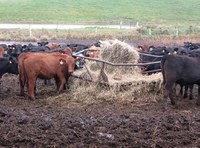Develop Strategies to Reduce Feed Waste
(Click the image below to view a high-resolution image that can be downloaded)
Hay loss and feed waste are inevitable components of most beef production systems.
“However, understanding the sources of hay loss from storage and feeding, as well as the impacts of restricting access to hay, can allow producers to develop strategies to optimize feed utilization on their operations,” says Carl Dahlen, North Dakota State University Extension Service beef cattle specialist.
The location of hay and whether it is covered during storage greatly affect the loss potential. For example, research evaluating hay loss found an average dry-matter loss of 28 percent, with a range of 5 to 61 percent, for hay stored outside without a cover.
Potential hay loss is reduced as the climate dries because precipitation, contact with wet ground and moisture from other bales are reduced. Dahlen recommends placing uncovered bales stored outside on a hard surface, in single rows, with bales stacked face to face. This eliminates moisture accumulation on the faces of bales and points where bales touch when stacked in a pyramid.
The hay loss evaluation showed that when hay was stored outside and covered, the loss fell to 13 percent, and bringing the hay into a building reduced the loss to about 5 percent. However, producers need to consider the economic merit of building a structure to store hay or purchasing tarps and covering haystacks before beginning construction or making purchases, Dahlen cautions.
A hay storage cost comparison tool is available at http://www.extension.iastate.edu/agdm/crops/xls/a1-15haystoragecost.xls to help producers explore the economic implications of different storage techniques.
Hay waste studies at NDSU, the University of Minnesota and Michigan State University discovered that cows fed processed and windrowed bales consumed more hay and had a 16-pound weight gain advantage during a 60-day feeding period compared with cows fed rolled-out bales. In addition, the amount of wasted hay was slightly greater for rolled-out bales than processed bales. However, an economic analysis showed the cost of feeding was greater when using a bale processor compared with rolling bales out for feeding.
“Producers evaluating the two scenarios need to consider whether additional pounds gained when feeding processed hay are worth the added expense,” Dahlen says. “In cases where greater intake is desired - for example, thin cows that need to put on weight - the added expense may be worthwhile.”
Feeding bales in a hay ring resulted in less waste compared with rolling bales out on the ground, according to the research. In addition, feeding processed hay in a bunk resulted in less waste than feeding processed hay on the ground.
In all cases, the hay intake was similar (about 26 pounds of hay, dry-matter basis), the research showed. The average waste for either of the ground feeding methods was about 18 percent, whereas the average waste from feeding in some type of structure was about 5 percent.
Feeding large round bales into a tapered-cone hay ring resulted in more weight gain compared with rolling bales out on the ground. It also resulted in less expensive overall feed costs compared with rolling hay on the ground and processing bales.
Tapered-cone hay rings also have shown promise when compared with other types of hay feeders, Dahlen says. Based on the research, cows eating from a tapered-cone ring wasted fewer pounds of hay but had similar hay intake compared with those eating from traditional hay rings, hay trailers or hay cradles. Authors of one report recommend that bales fed through a tapered-cone hay ring must be wrapped tightly and twine must not be removed to realize the waste-saving benefit from this type of feeder.
Reducing the amount of time cows have access to hay also may be an effective strategy to reduce hay waste. The research indicated that when cows were given access to hay for six, 14 or 24 hours per day, cows with hay access for six hours wasted the least amount of hay compared with the other groups.
The studies also found that body weight gain was impacted by restricting the cows’ access to hay. Cows with unlimited access to hay gained 20 pounds more than cows with restricted access to hay (six or 14 hours).
“While this method of managing cows could reduce overall feed consumption and hay waste, the long-term implications of such a management strategy are unknown,” Dahlen says. “Producers who decide to limit-feed cows in some fashion need to ensure that the feeding area is large enough so all cows can have access to the feed when it is delivered. The combination of limiting access to feed and restricting the time cattle have access to feed may leave cows on the lower end of the social hierarchy without a meal.”
NDSU Agriculture Communication - Oct. 28, 2011
| Source: | Carl Dahlen, (701) 231-5588, carl.dahlen@ndsu.edu |
|---|---|
| Editor: | Ellen Crawford, (701) 231-5391, ellen.crawford@ndsu.edu |


